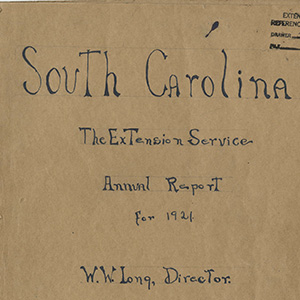About

Items in this collection represent annual reports for the extension state and county offices, as well as separate reports for the African American extension agents.
Started in 1907 with Dr. Seaman Knapp, an agriculturist and special agent for the USDA, the program was intended to be farm demonstrations to instruct farmers on proper farming techniques. At Clemson, it quickly grew into a program to include rural youth and women. During the early years, Rockefeller Foundation provided aid, although not enough, to help with the increases in demand for information and instruction. Relief came in 1914 with Congressman A. F. Lever sponsoring legislation to establish a national extension service along with the financial support to operate the programs. As a result of the passage of the Smith-Lever Act, extension work in South Carolina was carried out in conjunction with the college and the USDA. By 1930 each county had a county agent, a home demonstration agent, and in many counties, subject specialists. After WWII, the role expanded further to address concerns of urban as well as rural dwellers. Throughout its history, Extension has disseminated information on hundreds of topics ranging from farming techniques, financial management, consumerism, health, and nutrition.
Related Terms:
- Clemson University
Institution:
- Documents,
- Manuscripts
Media Types:
- Abbeville County,
- Aiken County,
- Allendale County,
- Anderson County,
- Bamberg County,
- Barnwell County,
- Beaufort County,
- Berkeley County,
- Calhoun County,
- Charleston County,
- Cherokee County,
- Chester County,
- Chesterfield County,
- Clarendon County,
- Colleton County,
- Darlington County,
- Dillon County,
- Dorchester County,
- Edgefield County,
- Fairfield County,
- Florence County,
- Georgetown County,
- Greenville County,
- Greenwood County,
- Hampton County,
- Horry County,
- Jasper County,
- Kershaw County,
- Lancaster County,
- Laurens County,
- Lee County,
- Lexington County,
- Marion County,
- Marlboro County,
- McCormick County,
- Newberry County,
- Oconee County,
- Orangeburg County,
- Pickens County,
- Richland County,
- Saluda County,
- Spartanburg County,
- Sumter County,
- Union County,
- Williamsburg County,
- York County
